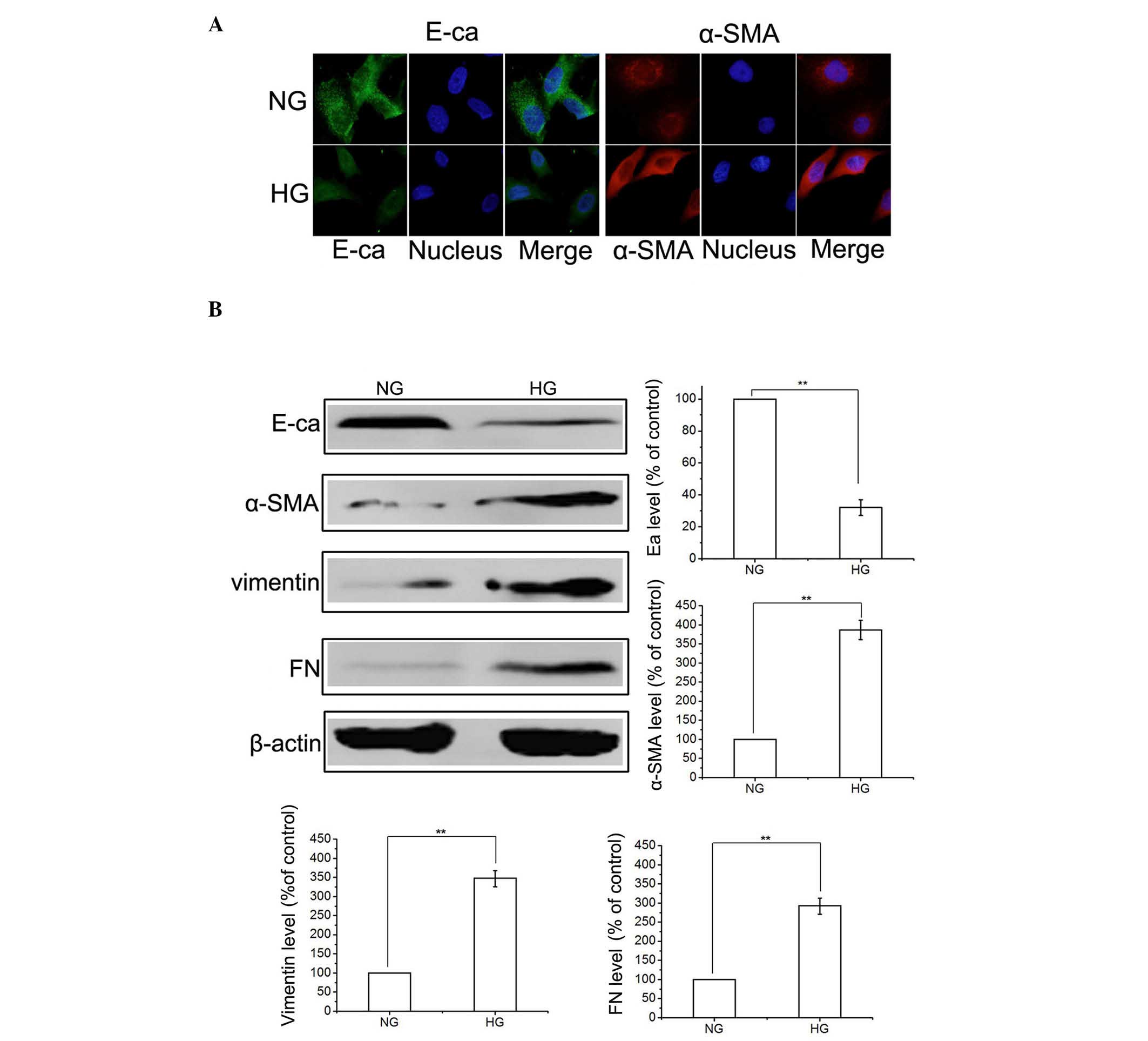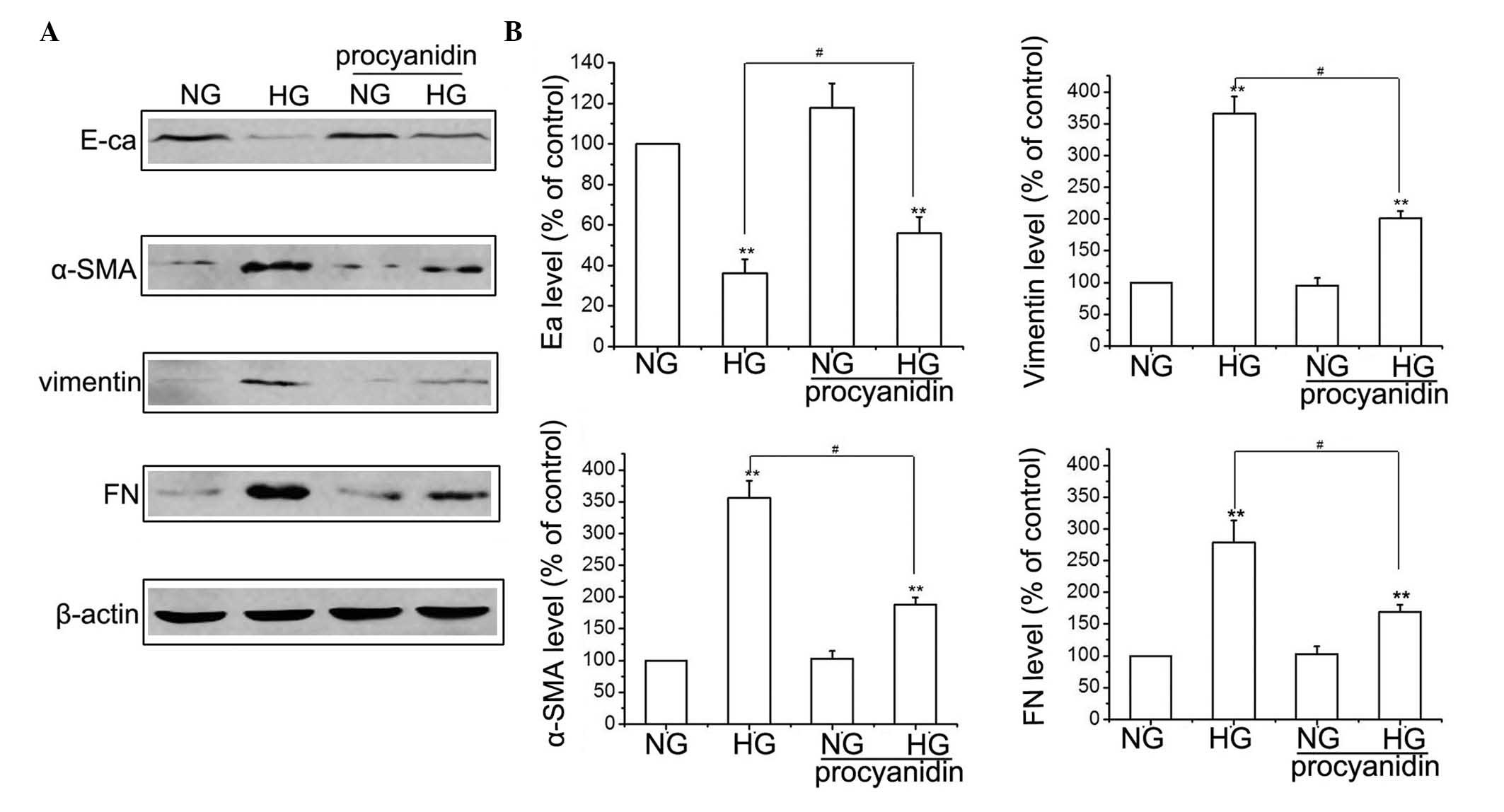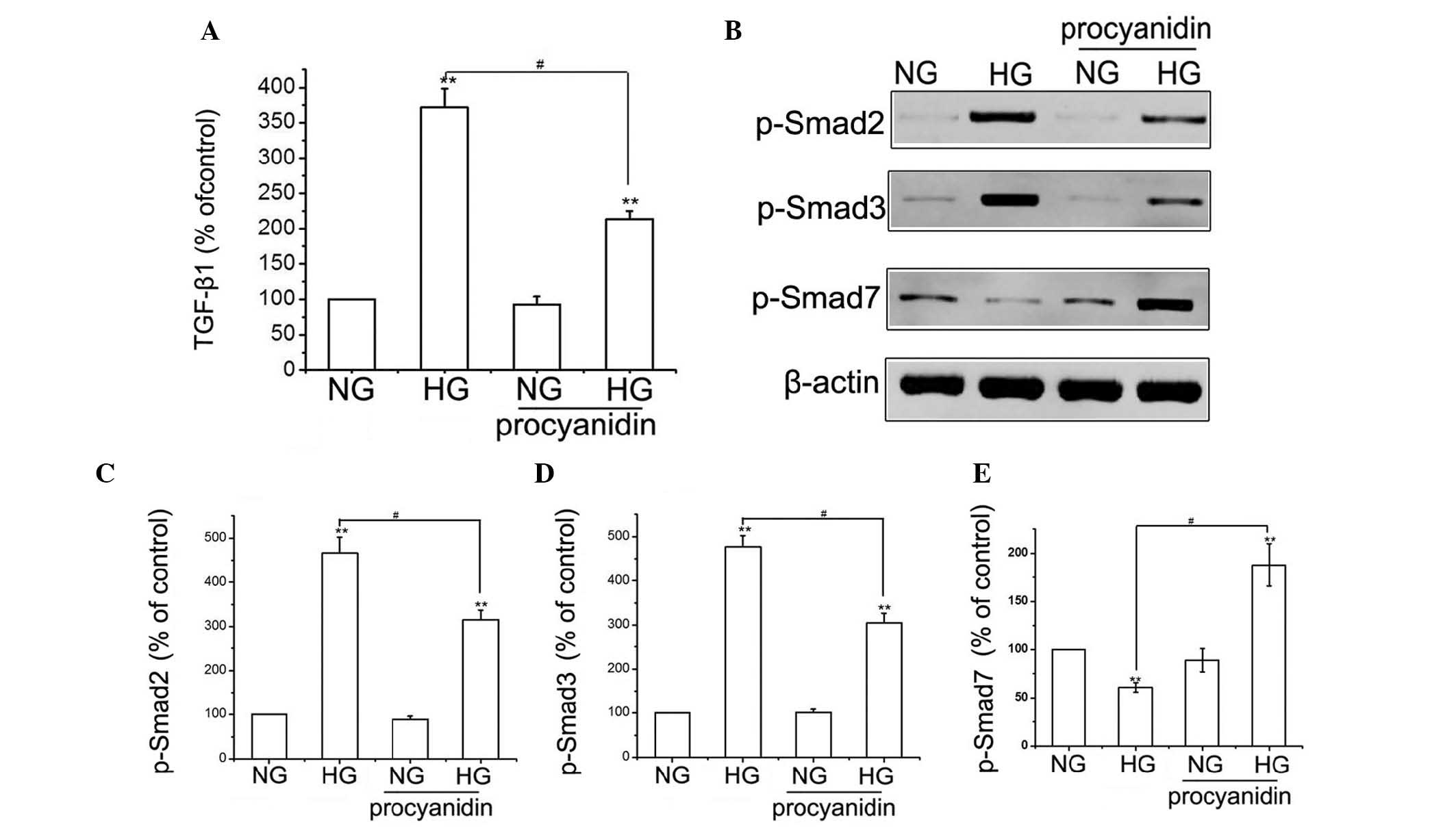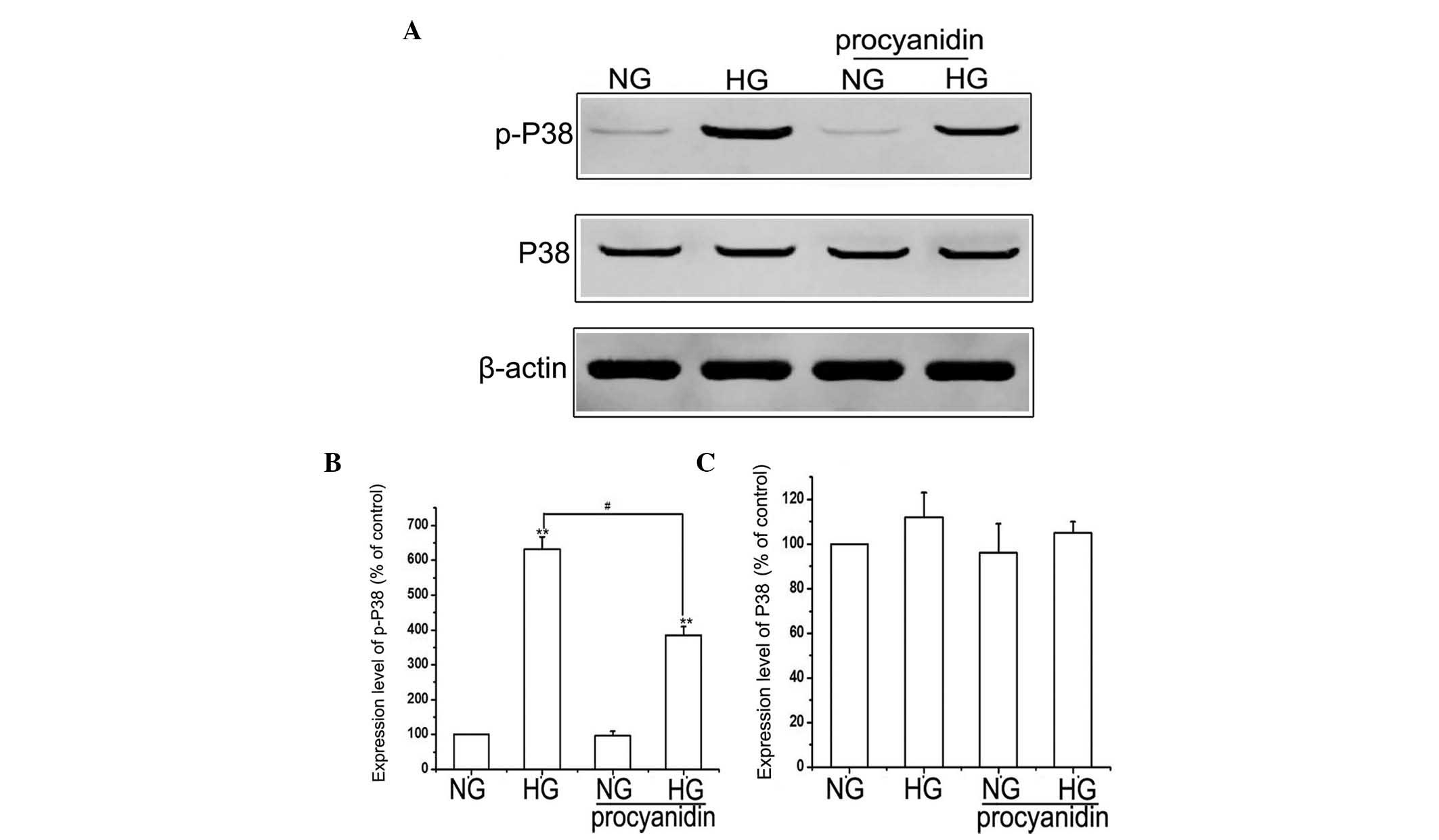Procyanidin B2 inhibits high glucose‑induced epithelial‑mesenchymal transition in HK‑2 human renal proximal tubular epithelial cells
- Authors:
- Published online on: October 15, 2015 https://doi.org/10.3892/mmr.2015.4445
- Pages: 8148-8154
Abstract
Introduction
Diabetic nephropathy (DN) is a chronic microvascular complication, which affects patients with diabetes. One of the most common characteristics of DN is diabetic glomerulosclerosis (1). A previous study demonstrated that the epithelial-mesenchymal transition (EMT)-like changes observed in podocytes are associated with podocyte detachment, which may result in focal glomerulosclerosis (2). Several studies have suggested that EMT, a process by which differentiated epithelial cells undergo a phenotypic conversion that gives rise to matrix-producing fibroblasts and myofibroblasts, may be important in the pathogenesis of diabetic kidney disease (3,4). The high glucose (HG)-induced EMT of renal tubular epithelial cells is a key process in glomerulosclerosis and, mediated by factors, including E-cadherin and α-smooth muscle actin (α-SMA), epithelial cells may lose their epithelial characteristics and gain mesenchymal cell properties (5,6). However, the process of HG-induced EMT remains to be fully elucidated.
Procyanidins are the most abundant polyphenols present in red wine, and they are also present in cereals, fruits, chocolate and tea (7). Several epidemiological studies have demonstrated that procyanidin B2 can inhibit hepatic and cardiac fibrosis (8,9). Based on the possible anti-fibrotic activity of procyanidins, the present study investigated whether procyanidins inhibit HG-induced EMT in the early stage of diabetic kidney glomerulosclerosis.
The transforming growth factor (TGF)-β/small mothers against decapentaplegic (Smad) and mitogen-activated protein kinase (MAPK)/P38 signaling pathways are involved in promoting EMT and are associated with the development of DN (10,11). The aim of the present study was to determine the role of the MAPK/P38 and TGF-β/Smad signaling pathways in HG-induced EMT, and to examine the changes in the two pathways in HK-2 cells cultured with procyanidin B2. The detailed investigation of this plant extract may provide a novel therapeutic strategy for the treatment of DN.
Materials and methods
Reagents
Dulbecco's modified Eagle's medium (DMEM), penicillin-streptomycin (5,000 U/ml penicillin; 5,000 U/ml streptomycin) and fetal bovine serum (FBS) were purchased from Gibco Life Technologies (Grand Island, NY, USA). D-glucose (analytical grade) was purchased from Guanghua Chemical Factory Co., Ltd. (Guangdong, China). Procyanidin B2 and Triton X-100 were purchased from Sigma-Aldrich (St. Louis, MO, USA). The anti-β-actin, anti-P38, anti-phosphorylated (p)-P38 and anti-p-Smad 2, 3 and 7 antibodies were purchased from Santa Cruz Biotechnology, Inc. (Dallas, TX, USA). The anti-fibronectin (FN), anti-α-SMA, anti-E-cadherin and anti-vimentin antibodies were purchased from BD Biosciences (Franklin Lakes, NJ, USA). An enhanced chemiluminescence (ECL) kit was purchased from Pierce Biotechnology, Inc. (Rockford, IL, USA). All reagents used were trace element analytical grade and all water used was glass distilled.
Cell culture
The HK-2 human renal proximal tubular epithelial cell line (CRL-2190; American Type Culture Collection, Danvers, MA, USA) was cultured at a density of 1×105 cells/ml in DMEM supplemented with 5.5 mmol/l D-glucose (normal glucose; NG) and 10% FBS at 37°C in a humidified atmosphere containing 5% CO2. The cells were subcultured every 3 days using 0.2% trypsin (Sigma-Aldrich) with 0.02% EDTA (Sigma-Aldrich). The near confluent HK-2 cells (80%) were subsequently transferred into serum-free DMEM for overnight starvation prior to each experiment. In order to induce EMT, the cells were cultured in high glucose (HG) medium containing 60 mmol/l D-glucose for 48 h at 37°C. The concentration was selected based on previous studies (12,13). To study the protective effects of procyanidin B2, HK-2 cells were incubated with 10 µM procyanidin B2 at 37°C in a humidified atmosphere for 48 h.
ELISA
The protein expression levels of TGF-β were measured using a TGF-β ELISA kit (R&D Systems, Minneapolis, MN, USA). Briefly, the HK-2 cells were seeded at a density of 4×105 cells/well into a 6-well plate and cultured for 24 h at 37°C. The supernatants were collected from the HK-2 cell cultures for ELISA. The secreted protein concentration of TGF-β per 105 cells was measured and calculated from the standard curve using the ELISA kit. Briefly, 100 µl samples were added to sample diluent and incubated for 1 h at 37°C with agitation, following washing with washing buffer (Sigma-Aldrich). Enzyme-conjugated secondary antibody was added to the wells and incubated for 2 h at 37°C prior to addition of the substrate solution. Absorbance was measured using an ELISA reader (Multiskan MK3; Thermo Fisher Scientific, Inc., Waltham, MA, USA) at a wavelength of 450 nm.
Western blot analysis
The cells were collected and washed with phosphate-buffered saline (PBS) prior to being lysed on ice for 30 min in lysis buffer (Beyotime Institute of Biotechnology, Haimen, China) containing 50 mM Tris (pH 8.1), 1% SDS, sodium pyrophosphate, β-glycerophosphate, sodium orthovanadate, sodium fluoride, EDTA, and leupeptin, and centrifuged at 15,000 x g for 30 min at room temperature. The supernatants were collected, and the protein concentration was determined using a Bicinchoninic Acid Protein Assay kit (Pierce Biotechnology, Inc.). The protein were boiled for 5 min and 10 µg total protein was loaded into the appropriate well to be separated by 10% SDS-PAGE (Beyotime Institute of Biotechnology). The proteins on the gel were then transferred onto a nitrocellulose membranes (EMD Millipore, Billerica, MA, USA) using a Bio-Rad A101441 apparatus (Bio-Rad Laboratories, Inc., Hercules, CA, USA) for 2 h at 4°C and 100 V. The protein-bound membranes were then blocked and washed in Tris-buffered saline with 20% Tween 20 (Sigma-Aldrich). The nitrocellulose membranes were cut according to the molecular weight of the protein, and were incubated with antibodies. The following primary antibodies were used: Anti-β-actin mouse monoclonal IgG1 (1:400; cat. no. sc-8432; Santa Cruz Biotechnology, Inc.; 24 h incubation at 4°C), anti-α-SMA goat polyclonal IgG (1:400; cat. no. sc-324317; Santa Cruz Biotechnology, Inc.; 24 h incubation at 4°C), anti-E-cadherin mouse monoclonal IgG1 (1:400; cat. no. sc-52327; Santa Cruz Biotechnology, Inc.; 24 h incubation at 4°C), anti-FN mouse monoclonal IgG1 (1:400; cat. no. sc-52331; Santa Cruz Biotechnology, Inc.; 24 h incubation at 4°C), anti-vimentin mouse monoclonal IgG1 (1:400; cat. no. sc-373717; Santa Cruz Biotechnology, Inc.; 24 h incubation at 4°C), anti-P38 mouse monoclonal IgG1 (1:400; cat. no. sc-33688; Santa Cruz Biotechnology, Inc.; 24 h incubation at 4°C), anti-p-P38 mouse monoclonal IgG1 (1:400; cat. no. sc-7973; Santa Cruz Biotechnology, Inc.; 24 h incubation at 4°C), anti-p-Smad 2 mouse monoclonal IgG1 (1:400; cat. no. sc-393312; Santa Cruz Biotechnology, Inc.; 24 h incubation at 4°C), anti-p-Smad 3 mouse monoclonal IgG1 (1:400; cat. no. sc-101154; Santa Cruz Biotechnology, Inc.; 24 h incubation at 4°C) and anti-p-Smad 7 mouse monoclonal IgG1 (1:400; cat. no. sc-365846; Santa Cruz Biotechnology, Inc.; 24 h incubation at 4°C). The membranes were then incubated with goat anti-mouse IgG2a-B peroxidase-conjugated secondary antibodies (1:400; cat. no. sc-2073; Santa Cruz Biotechnology, Inc.; 24 h incubation at 4°C). The blots were visualized using an ECL kit (Pierce Biotechnology, Inc.) and the relative quantities of the proteins were analyzed. The results were quantified using Quantity One software V4.62 (Bio-Rad Laboratories, Inc.).
Fluorescence microscopy
The cells (1×105 cells/ml) were washed once with ice-cold PBS and fixed with 4% paraformaldehyde (Sigma-Aldrich) for 30 min at 4°C. Following being washed three times with PBS, the cells were incubated with 1% Triton X-100 for 10 min. The cells were blocked at nonspecific antibody binding sites by incubating in PBS containing 0.3% Triton X-100 and 0.5% bovine serum albumin (Sigma-Aldrich) for 30 min at room temperature. The cells were subsequently incubated with an antibody targeting E-cadherin or α-SMA (1:200) overnight at room temperature. Subsequently, the cells were incubated with a fluorescein isothiocyanate- or tetramethylrhodamine-conjugated immunoglobulin G antibody (1:100 in PBS) for 0.5 h at room temperature. Hoechst 33342 (10 µg/ml; Sigma-Aldrich) was then added to the cells for 15 min at room temperature. Following three washes with PBS, the cells were visualized under a fluorescence microscope (Olympus SZ51; Olympus Corporation, Tokyo, Japan).
Statistical analysis
Data are expressed as the mean ± standard error of the mean. Variance was homogenous enabling use of the standard one-way analysis of variance (ANOVA) methodology. On establishment of statistical significance using ANOVA, individual comparisons were made using Tukey's multiple comparison test. P<0.05 was considered to indicate a statistically significant difference. Statistical analyses were performed using SPSS version 18 (SPSS, Inc., Chicago, IL, USA).
Results
HG induces HK-2 cells to undergo EMT
To determine whether HG induced EMT, the HK-2 cells were incubated in NG (5.5 mmol/l D-glucose) or HG (60 mmol/l D-glucose) conditions. Initially, exposure of the HK-2 cells to HG for 48 h decreased the protein expression levels of E-cadherin and increased the expression levels of α-SMA, compared with the NG group, determined by immunofluorescence (Fig. 1A). In addition, HG-induced EMT was confirmed by western blotting, which indicated the upregulation of α-SMA, FN and vimentin and the downregulation of E-cadherin (Fig. 1B). These results suggested that an HG environment activated the EMT process in the HK-2 cells.
Effects of procyanidin B2 on the expression of EMT-associated proteins in HG-induced HK-2 cells
To determine the effects of procyanidin B2 in EMT, the HK-2 cells were treated with or without 60 mmol/l D-glucose for 48 h, in the presence or absence of procyanidin B2. The expression levels of FN, E-cadherin, vimentin and α-SMA were detected using western blotting. As shown in Fig. 2, exposure of the HK-2 cells to HG for 48 h decreased the protein expression levels of E-cadherin and increased the expression levels of FN, α-SMA and vimentin, compared with the NG group. However, HG-induced EMT was attenuated when the HK-2 cells were pre-treated with 10 µM procyanidin B2, which was indicated by the reduced expression levels of FN, α-SMA and vimentin, and the increased expression of E-cadherin (Fig. 2). The concentration of procyanidin B2 was selected based on a previous study (14). These results suggested that procyanidin B2 supplementation reversed HG-induced EMT in the HK-2 cells.
Effects of procyanidin B2 on the expression of TGF-β/Smad in HK-2 cells
The TGF-β/Smads signaling pathway is considered to contribute to the development of DN by increasing glomerulosclerosis and inducing EMT (15,16). To determine the effects of procyanidin B2 on the expression of TGF-β in HG-treated HK-2 cells, the protein expression of TGF-β was measured using ELISA (Fig. 3A). Compared with the NG group, the expression of TGF-β was significantly higher in the HG-treated group; however, treatment with procyanidin B2 reduced the HG-induced expression of TGF-β. Furthermore, the effects of procyanidin B2 on HG-induced expression of Smads in the HK-2 cells were examined using western blotting. HG treatment resulted in a substantial increase in the expression levels of p-Smad2 and p-Smad3, and decreased the protein expression of p-Smad7 in the HK-2 cells. However, procyanidin B2 pre-treatment significantly attenuated HG-induced expression of p-Smad2 and p-Smad3, and increased the expression of p-Smad7 in the HK-2 cells (Fig. 3B–E). These results indicated that procyanidin B2 inhibited HG-induced EMT via the TGF-β/Smads signaling pathway.
Effects of procyanidin B2 on the expression of MAPK/P38 in HK-2 cells
The MAPK/P38 signaling pathway has previously been reported to be involved in EMT (17); however, whether procyanidin B2 exerts its effect on EMT in HK-2 cells via this pathway remains to be elucidated. Therefore, the present study examined the effect of procyanidin B2 supplementation on the MAPK/P38 pathway. Compared with the NG group, the expression of p-P38 was upregulated by HG, whereas the expression levels of total P38 were not significantly altered. Notably, pre-treatment of the HK-2 cells with procyanidin B2 significantly inhibited the HG-induced expression of p-P38. However, no significant difference was observed in the expression of total P38 in the HG+procyanidin B2 group, compared with the HG group (Fig. 4). These results suggested that procyanidin B2 may be involved in HG-induced EMT via regulation of the MAPK/P38 pathway.
Discussion
The pathogenesis of DN is the result of several factors, and insulin metabolism disorder as a result of long-term high blood sugar is considered the predominant cause of DN (18). Renal hemodynamic changes caused by high blood sugar, and the series of consequences of abnormal glucose metabolism are the basis of kidney disease (19). HG-induced EMT is an important process, leading to glomerulosclerosis and tubulointerstitial fibrosis (5). EMT is described as the loss of epithelial characteristics from epithelial cells, and the acquisition of properties typical of mesenchymal cells. EMT facilitates cell movement and the generation of novel tissue types during development, and also contributes to the pathogenesis of disease (20,21). The characteristics of EMT essential to wound healing also link EMT to organ fibrosis, including pulmonary, renal and hepatic fibrosis (20). A previous study demonstrated that tubular epithelium can transdifferentiate into fibroblasts via the process of EMT, which is regarded as an important event in the pathogenesis of tubulointerstitial fibrosis (22). The findings of the present study were consistent with these previous results. HG-induced EMT was confirmed using western blotting, which detected the upregulation of α-SMA, FN and vimentin, and the downregulation of E-cadherin, associated with a transition from the epithelial phenotype of HK-2 cells to a myofibroblastic phenotype.
Proanthocyanidins are a class of substances, which are linked by catechin, epicatechin and gallate (23). Procyanidin B2 is a biologically active component of grape seeds, which has been reported to possess various pharmacological and biochemical effects (24). The effects of procyanidin B2 on various types of cancer have been reported (25,26); however, the effects of procyanidin B2 on EMT in human renal proximal tubular epithelial cells remain to be fully elucidated. The present study investigated the effects of procyanidin B2 on HG-induced EMT, and examined the underlying mechanisms. The occurrence of oxidative stress is key in EMT (27), and procyanidin B2, which is present in grape seeds, apples and cacao beans, has antioxidant properties (28). Therefore, the present study hypothesized that procyanidin B2 may have an inhibitory effect on EMT. The results of the present study demonstrated that procyanidin B2 treatment provided effective protection against HG-induced EMT, evidenced by a decrease in the upregulation of vimentin and α-SMA, and the amelioration of E-cadherin in the human renal proximal tubular epithelial cell line (Fig. 2).
TGF-β has been described as a ʻmaster switchʼ regulating EMT, and has been demonstrated to signal primarily via the Smad 2/3 pathway (29). Smad7 is crucial in antagonizing EMT induced by TGF-β signaling (30). The present study demonstrated that procyanidin B2 pre-treatment significantly attenuated HG-induced EMT by directly downregulating p-Smad2 and 3, and indirectly upregulating p-smad7; accompanied by a decrease in the upregulation of FN, α-SMA and vimentin, and an increase in the downregulation of E-cadherin. The downstream effects of TGF-β may not only be as a consequence of the Smads signaling pathway, but may be the result of multiple signaling pathways, acting to modulate the effects of TGF-β signaling. Activation of the MAPK/P38 signaling pathway is not exclusive to TGF-β and may be activated to induce EMT (31). The present study also demonstrated that procyanidin B2 significantly inhibited the HG-induced expression of p-P38 and weakened HG-induced EMT.
In conclusion, the results of the present study demonstrated that procyanidin B2 inhibited HG-induced EMT, most likely via inhibition of the expression of TGF-β, p-Smad2 and 3, as well as the P38/MAPK signaling pathway, in HK-2 cells. The identification of procyanidin B2 as an inhibitor of HG-induced EMT represents an important finding. Further investigations may examine this target for limiting EMT and for the treatment of DN.
Abbreviations:
|
HG |
high glucose |
|
DMEM |
Dulbecco's modified Eagle's medium |
|
FITC |
fluorescein isothiocyanate |
|
RIPA |
radioimmunoprecipitation assay |
|
TGF |
transforming growth factor |
|
EMT |
epithelial-mesenchymal transition |
|
SMA |
smooth muscle cell actin, ROS, reactive oxygen species |
|
MAPK |
mitogen-activated protein kinase |
|
DN |
diabetic nephropathy |
|
PBS |
phosphate-buffered saline |
Acknowledgments
The present study was supported by the Military Logistics Research Programs of China (grant no. CJN10L075) and by the China Postdoctoral Science Foundation (grant no. 2012M512175).
References
|
Zhao HL, Lai FM, Tong PC, Tomlinson B and Chan JC: Clinicopathologic characteristics of nodular glomerulosclerosis in Chinese patients with type 2 diabetes. Am J Kidney Dis. 44:1039–1049. 2004. View Article : Google Scholar : PubMed/NCBI | |
|
Samejima K, Nakatani K, Suzuki D, Asai O, Sakan H, Yoshimoto S, Yamaguchi Y, Matsui M, Akai Y, Toyoda M, et al: Clinical significance of fibroblast-specific protein-1 expression on podocytes in patients with focal segmental glomerulosclerosis. Nephron Clin Pract. 120:c1–c7. 2012. View Article : Google Scholar | |
|
Liu Y: New insights into epithelial-mesenchymal transition in kidney fibrosis. J Am Soc Nephrol. 21:212–222. 2010. View Article : Google Scholar | |
|
Carew RM, Wang B and Kantharidis P: The role of EMT in renal fibrosis. Cell Tissue Res. 347:103–116. 2012. View Article : Google Scholar | |
|
Li J, Kang SW, Kim JL, Sung HY, Kwun IS and Kang YH: Isoliquiritigenin entails blockade of TGF-beta1-SMAD signaling for retarding high glucose-induced mesangial matrix accumulation. J Agric Food Chem. 58:3205–3212. 2010. View Article : Google Scholar : PubMed/NCBI | |
|
Tang L, Li H, Gou R, Cheng G, Guo Y, Fang Y and Chen F: Endothelin-1 mediated high glucose-induced epithelial-mesenchymal transition in renal tubular cells. Diabetes Res Clin Pract. 104:176–182. 2014. View Article : Google Scholar : PubMed/NCBI | |
|
Quesada IM, Del Bas JM, Bladé C, Ardèvol A, Blay M, Salvadó MJ, Pujadas G, Fernández-Larrea J and Arola L: Grape seed procyanidins inhibit the expression of metallothione in genes in human HepG2 cells. Genes Nutr. 2:105–109. 2007. View Article : Google Scholar | |
|
Palfi A, Bartha E, Copf L, Mark L, Gallyas F Jr, Veres B, Kalman E, Pajor L, Toth K, Ohmacht R and Sumegi B: Alcohol-free red wine inhibits isoproterenol-induced cardiac remodeling in rats by the regulation of Akt1 and protein kinase C alpha/beta II. J Nutr Biochem. 20:418–425. 2009. View Article : Google Scholar | |
|
Choi JH, Hwang YP, Choi CY, Chung YC and Jeong HG: Anti-fibrotic effects of the anthocyanins isolated from the purple-fleshed sweet potato on hepatic fibrosis induced by dimethylnitrosamine administration in rats. Food Chem Toxicol. 48:3137–3143. 2010. View Article : Google Scholar : PubMed/NCBI | |
|
Rodrigues-Diez R, Rodrigues-Diez RR, Lavoz C, Carvajal G, Droguett A, Garcia-Redondo AB, Rodriguez I, Ortiz A, Egido J, Mezzano S and Ruiz-Ortega M: Gremlin activates the Smad pathway linked to epithelial mesenchymal transdifferentiation in cultured tubular epithelial cells. Biomed Res Int. 2014:8028412014. View Article : Google Scholar : PubMed/NCBI | |
|
Antoon JW, Nitzchke AM, Martin EC, Rhodes LV, Nam S, Wadsworth S, Salvo VA, Elliott S, Collins-Burow B, Nephew KP and Burow ME: Inhibition of p38 mitogen-activated protein kinase alters microRNA expression and reverses epithelial-to-mesenchymal transition. Int J Oncol. 42:1139–1150. 2013.PubMed/NCBI | |
|
Rodrigues-Díez R, Carvajal-González G, Sánchez-López E, Rodríguez-Vita J, Rodrigues Díez R, Selgas R, Ortiz A, Egido J, Mezzano S and Ruiz-Ortega M: Pharmacological modulation of epithelial mesenchymal transition caused by angiotensin II. Role of ROCK and MAPK pathways. Pharm Res. 25:2447–2461. 2008. View Article : Google Scholar : PubMed/NCBI | |
|
Gu L, Gao Q, Ni L, Wang M and Shen F: Fasudil inhibits epithelial-myofibroblast transdifferentiation of human renal tubular epithelial HK-2 cells induced by high glucose. Chem Pharm Bull (Tokyo). 61:688–694. 2013. View Article : Google Scholar | |
|
Cai Q, Li BY, Gao HQ, Zhang JH, Wang JF, Yu F, Yin M and Zhang Z: Grape seed procyanidin b2 inhibits human aortic smooth muscle cell proliferation and migration induced by advanced glycation end products. Biosci Biotechnol Biochem. 75:1692–1697. 2011. View Article : Google Scholar : PubMed/NCBI | |
|
O'Kane D, Jackson MV, Kissenpfennig A, Spence S, Damkat-Thomas L, Tolland JP, Smyth AE, Denton CP, Stuart Elborn J, McAuley DF and O'Kane CM: SMAD inhibition attenuates epithelial to mesenchymal transition by primary keratinocytes in vitro. Exp Dermatol. 23:497–503. 2014. View Article : Google Scholar : PubMed/NCBI | |
|
Islam SS, Mokhtari RB, El Hout Y, Azadi MA, Alauddin M, Yeger H and Farhat WA: TGF-β1 induces EMT reprogramming of porcine bladder urothelial cells into collagen producing fibroblasts-like cells in a Smad2/Smad3-dependent manner. J Cell Commun Signal. 8:39–58. 2014. View Article : Google Scholar : | |
|
Antoon JW, Nitzchke AM, Martin EC, Rhodes LV, Nam S, Wadsworth S, Salvo VA, Elliott S, Collins-Burow B, Nephew KP and Burow ME: Inhibition of p38 mitogen-activated protein kinase alters microRNA expression and reverses epithelial-to-mesenchymal transition. Int J Oncol. 42:1139–1150. 2013.PubMed/NCBI | |
|
Yeh WJ, Yang HY and Chen JR: Soy β-conglycinin retards progression of diabetic nephropathy via modulating the insulin sensitivity and angiotensin-converting enzyme activity in rats fed with high salt diet. Food Funct. 5:2898–2904. 2014. View Article : Google Scholar : PubMed/NCBI | |
|
Filippone EJ, Gupta A and Farber JL: Normoglycemic diabetic nephropathy: The role of insulin resistance. Case Rep Nephrol Urol. 4:137–143. 2014. View Article : Google Scholar : PubMed/NCBI | |
|
Kothari AN, Mi Z, Zapf M and Kuo PC: Novel clinical therapeutics targeting the epithelial to mesenchymal transition. Clin Transl Med. 3:352014. View Article : Google Scholar : PubMed/NCBI | |
|
Srivastava SP, Koya D and Kanasaki K: MicroRNAs in kidney fibrosis and diabetic nephropathy: Roles on EMT and EndMT. Biomed Res Int. 2013:1254692013. View Article : Google Scholar : PubMed/NCBI | |
|
Fintha A, Gasparics Á, Fang L, Erdei Z, Hamar P, Mózes MM, Kökény G, Rosivall L and Sebe A: Characterization and role of SCAI during renal fibrosis and epithelial-to-mesenchymal transition. Am J Pathol. 182:388–400. 2013. View Article : Google Scholar | |
|
Rinaldi A, Jourdes M, Teissedre PL and Moio L: A preliminary characterization of Aglianico (Vitis vinifera L. cv) grape proanthocyanidins and evaluation of their reactivity towards salivary proteins. Food Chem. 164:142–149. 2014. View Article : Google Scholar : PubMed/NCBI | |
|
Agarwal C, Veluri R, Kaur M, Chou SC, Thompson JA and Agarwal R: Fractionation of high molecular weight tannins in grape seed extract and identification of procyanidin B2-3,3′-di-O-gallate as a major active constituent causing growth inhibition and apoptotic death of DU145 human prostate carcinoma cells. Carcinogenesis. 28:1478–1484. 2007. View Article : Google Scholar : PubMed/NCBI | |
|
Chou SC, Kaur M, Thompson JA, Agarwal R and Agarwal C: Influence of gallate esterification on the activity of procyanidin B2 in androgen-dependent human prostate carcinoma LNCaP cells. Pharm Res. 27:619–627. 2010. View Article : Google Scholar : PubMed/NCBI | |
|
Avelar MM and Gouvêa CM: Procyanidin b2 cytotoxicity to mcf-7 human breast adenocarcinoma cells. Indian J Pharm Sci. 74:351–355. 2012. View Article : Google Scholar | |
|
Liu J, Zeng L, Zhao Y, Zhu B, Ren W and Wu C: Selenium suppresses lipopolysaccharide-induced fibrosis in peritoneal mesothelial cells through inhibition of epithelial-to-mesenchymal transition. Biol Trace Elem Res. 161:202–209. 2014. View Article : Google Scholar : PubMed/NCBI | |
|
Sakano K, Mizutani M, Murata M, Oikawa S, Hiraku Y and Kawanishi S: Procyanidin B2 has anti- and pro-oxidant effects on metal-mediated DNA damage. Free Radic Biol Med. 39:1041–1049. 2005. View Article : Google Scholar : PubMed/NCBI | |
|
Borthwick LA, Gardner A, De Soyza A, Mann DA and Fisher AJ: Transforming growth factor-β1 (TGF-β1) driven epithelial to mesenchymal transition (EMT) is accentuated by tumour necrosis factor α (TNFα) via crosstalk between the SMAD and NF-κB pathways. Cancer Microenviron. 5:45–57. 2012. View Article : Google Scholar | |
|
Tsai TH, Sun MH, Ho TC, Ma HI, Liu MY and Tsao YP: Notch prevents transforming growth factor-beta-assisted epithelial-mesenchymal transition in cultured limbal progenitor cells through the induction of Smad7. Mol Vis. 20:522–534. 2014.PubMed/NCBI | |
|
Chen HH, Zhou XL, Shi YL and Yang J: Roles of p38 MAPK and JNK in TGF-β1-induced human alveolar epithelial to mesenchymal transition. Arch Med Res. 44:93–98. 2013. View Article : Google Scholar : PubMed/NCBI |













